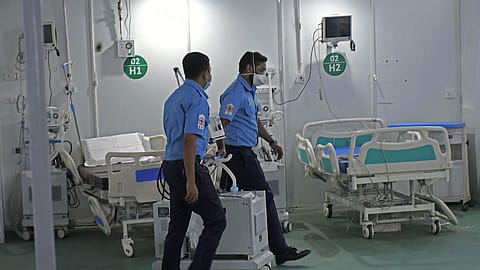The DRDO’s defence against Covid-19
The Defence Research and Development Organisation in India has shown, during the Covid-19 pandemic, how strong scientific organisations can help in a health crisis.

One would not, in common understanding, usually connect India’s main military research and development organisation with opening a lifesaving hospital.
But through the Covid-19 crisis, the Defence Research and Development Organisation (DRDO) has consistently delivered some of the best plug-and-play makeshift hospitals during the pandemic that hit the country in March 2020. The organisation’s 500-bed hospital in Delhi manned mostly by doctors of the Armed Forces Medical Services has been a lifesaver for many. Such facilities were opened around the same time in other locations around the country too. In its most recent work against Covid-19, DRDO has also developed an antibody detection kit.
That is not all. Last year DRDO scientists came up with a quick and effective design for a low- cost ventilator. The ventilator, named DEVEN (acronym for DRDO Economical Ventilator), was designed by scientists of the Institute of Nuclear Medicine and Allied Sciences Laboratory at the Dr. A. P. J. Abdul Kalam Missile Complex, DRDO. According to a paper on this product written by researchers of the Indian National Academy of Engineering, “DEVEN has features comparable to high-end ventilators and would serve the requirements of a large number of ventilators under the present COVID-19 pandemic situation. Also, DEVEN being a portable ventilator can be used in field application using a portable air compressor and reservoir. Hence, it can be used in an ambulance, any mobile vehicle or for application in any remote/rural area”.
The researchers noted that though low-cost the portable ventilator had, “… precise measurement and control/adjustment of important patient parameters such as inspiratory pressure, respiration (breathe) rate, inhaling–exhaling (I:E) ratio, tidal volume, and percentage oxygen (FiO2)”.
This year the DRDO has done one better. It has repurposed an anti-cancer drug to be used in the treatment of Covid-19. The 2-DG (2-deoxy-D-Glucose) was first developed by DRDO as a radio-sensitizer compound when used as an adjuvant to radio-therapy of cancer patients; and conducted successful phase I and II clinical trials in brain tumor patients.
“After Pokharan nuclear tests in 1998, when the U.S. imposed sanctions on import of 2-DG into the country, DRDO developed indigenous technology of 2-DG synthesis and transferred the technology to Dr Reddy’s Lab, Hyderabad (DRL) for the production of drug in 2004. Later, DRDO along with DRL conducted Phase-Ill clinical trial of 2-DG in brain tumor (Glioblastoma Multiforme) patients at reputed hospitals of India including AIIMS New Delhi, Tata Memorial Hospital Mumbai, VIMHANS Bangalore, Dharmashila Cancer Hospital, Noida, and several other centres of clinical excellence till 2009,” states a research note on the drug released by DRDO.
The drug was first tested against SARS-CoV-2. The 2-DG drug had already had a clinical trial, though, as explained earlier, it was for a different reason, but if it could be shown to be effective against SARS-CoV-2, there was a high chance that it would work against Covid-19. The Centre for Cellular and Molecular Biology at Hyderabad tested 2-DG which showed, as the note details, “excellent efficacy in the experiments using virus- infected cells. It clears nearly 99 % viral load at safe (non-toxic to cells) dose of 2-DG. At higher and safe concentrations of the drug, negligible virus were detected, which means it not only slows down but completely stops the viral replication/reproduction in infected cells”.
Recommended Stories
It is after this that, with the coming of the second wave of the deadly Coronavirus, that 2-DG was considered for use against Covid-19. After two rounds of successful trials, phase three trials on the medicine are now being conducted, and its success could give significant boost to the fight against Covid-19 in the country. In the meantime, encouraged by results till date, the Drug Controller General of India has approved it for emergency use as adjunctive therapy against Covid-19 (moderate to severe cases).
DRDO is not alone. ISRO (Indian Space Research Organisation) has used its own technical prowess to build SWAAS, portable medical oxygen concentrator, and the device is able to supply oxygen at a steady rate of 10 LPM (litres per minute) to two patients at one time. It can also boost oxygen levels by separating nitrogen gas from normal air using the Pressure Swing Absorption (PSA) technique. ISRO has also built a geo-portal BHUVAN-Covid-19 to track the spread of the pandemic.
These organisations and their work during the pandemic have one important lesson: investment in science never goes to waste. Therefore, greater investment in building a scientific temper, encouraging students to take up science as a subject of study (including medicine) pays dividends in crisis moments in directions that could have perhaps never been imagined.
Views are personal. The author is a historian and a columnist. He is a multiple award-winning author of nine books.
(INR CR)